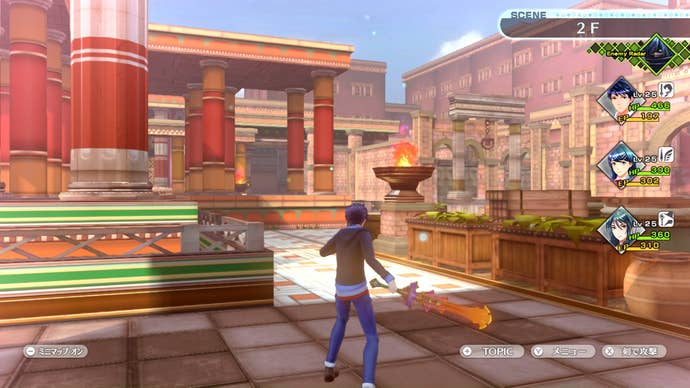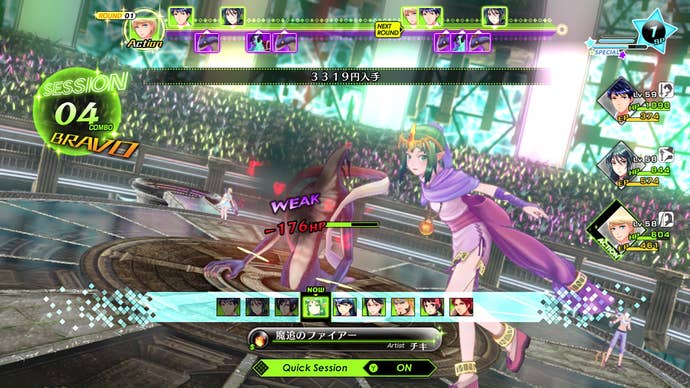Tokyo Mirage Sessions #FE Encore Review: Put This Song on Repeat
An overlooked Wii U RPG gets deserved top billing on Switch.
This article first appeared on USgamer, a partner publication of VG247. Some content, such as this article, has been migrated to VG247 for posterity after USgamer's closure - but it has not been edited or further vetted by the VG247 team.
My home country of Canada is very fond of a dish called poutine. You've likely heard of it, because people around the world wonder what first possessed us to mix fries, gravy, and cheese curds. The concept of poutine might sound weird—or gross—to a person hearing about it for the first time, but rest assured the unorthodox combination of ingredients is extremely edible. In fact, consuming the concoction guarantees happiness.
Tokyo Mirage Sessions #FE is video game poutine. There isn't much logical reason why combining the Shin Megami Tensei/Persona RPG series with Fire Emblem and idol culture should work, but it does. More than that, #FE Encore for the Switch offers additional content and quality of life improvements to the original Wii U adventure. Some flaws remain, but #FE Encore is still one of the best and most unique RPGs available for the Switch.
If you've been squirming excitedly since #FE Encore was announced, then you already know the sad tale of how Tokyo Mirage Sessions #FE failed to find an audience when it came to the Wii U in 2015. The idol iteration of Chrom faded alongside Nintendo's doomed console, even though Fire Emblem hype had reached new levels thanks to 2012's Fire Emblem Awakening for the Nintendo 3DS. #FE Encore gives everyone a chance to play a great RPG for a system they actually bought. (Sorry, Nintendo.) There's a lot of anticipation and hype surrounding #FE Encore, and it's largely justified.
#FE Encore's story isn't the most engaging tale in RPG history, but it's charming. A young man named Itsuki Aoi lives in an alternate version of Japan where digital and real world "3D" pop idols permeate every facet of life and entertainment. The public's love of idols runs deep despite—or perhaps because of—an incident that saw a famous pop idol literally disappear into thin air during a show.
Fascinated by the disappearance for their own reasons, Itsuki and his friends wind up in the thick of supernatural happenings. Their struggle is against the corrupting influence of "Mirages", #FE Encore's version of the mystical Personas. Enter Chrom and several other Fire Emblem characters as friendly Mirages that pair up with Itsuki and company, though none of them can recall why they were pulled to Itsuki's world to begin with. The reasons gradually become clearer, though not before you plunge into the "Idolasphere" and engage in a lot of fights against the evil Mirages and the people controlling them.

The dungeons found in #FE Encore's Idolasphere fall between Persona 4 and Persona 5 in theme and complexity. While they're more defined than Persona 4's procedurally generated labyrinths, they lack the personality of Persona 5's settings. There are some simple puzzles to tackle in each dungeon, but nothing that sticks in your mind. That's fine, because the real star of Tokyo Mirage Sessions #FE Encore gets top billing right there in the name: the "Sessions" that are a key part of the battle system.
When you start a fight in #FE Encore, you can opt to just attack foes with your weapons. That's a good way to die, as the enemies you face off against are generally pretty tough and regular attacks hardly dent them. As with most Shin Megami Tensei and Persona games, the key to your continued survival in #FE Encore lies with powerful Skill-based attacks. Exploiting a bad guy's elemental weakness with a Skill can trigger a chain attack called a Session. The conditions for executing a Session depend on the passive Skills Itsuki and his friends collect as they trek through the Idolasphere and level up, but in time, select NPCs will be able to join in on sessions too.
As satisfying as Sessions are to watch, they're also the area where one of #FE Encore's best quality of life improvements gets to shine. The new "Quick Sessions" option lets Sessions play out instantly, an unspeakably valuable addition if you don't want to sit through a procession of supplementary attacks every time you smack a schmuck with their weakness. In fact, #FE Sessions generally moves more quickly than the Wii U release. Load times, a major complaint for the first version of the game, have been drastically reduced according to comparisons between the two.

Some areas of #FE Encore can still use an injection of hustle, however. A lot of time is spent in menus, fiddling with weapon and skill optimization. Party members learn skills through their weapons, which gain experience points after each battle. Weapons level up quickly, which is nice, but each character can only learn a limited number of spells. Before long, nearly every victory is followed by several minutes of deciding which spells you should hang onto, and which should go. Worse, once you've mastered a weapon, you have to forge another to learn more spells—which means more time in menus, comparing skills and stats. Yes, it's a lot like optimizing the spells you learn from Personas in the Persona games, but the pace at which you learn Persona's spells feels more manageable.
The menus in Persona 4 and 5 also feel cleaner than the menus in #FE Encore and are generally easier to navigate as a result. I had a hard time getting used to #FE Encore's menus; I was still hitting wrong buttons and searching for certain sub-sections after 30 or 40 hours of play. (You can expect around 60 hours of content depending on how many sub quests you tackle, by the way.) Said menus are designed to look and operate like a smartphone app, and while they're cute and match the game's idol theme perfectly, they're a bit cluttered. #FE Encore doesn't walk the thin line between style and function as nimbly as Persona 5 does.
Fortunately, #FE Encore's menu and pacing problems are just a couple of scuffs on the game's glittering, golden presentation. #FE Encore's sense of style isn't on par with Persona 5's, but it's nothing to turn away from. I eagerly waited for each new inductee to my group because I loved seeing the new design takes on Fire Emblem's veteran cast. I also appreciate how Itsuki's friends are partnered with perfect Fire Emblem counterparts—mostly. Tiny microwave cooking star Mamori is paired with the heavily-armored Draug, and watching her attempt to heft around Draug's enormous axe is hilarious. For an 11-year-old girl, though, she is an excellent tank.
When #FE failed to make an impression on RPG fans in 2015, it wasn't the game's fault. Now that it's a well-advertised game on a popular platform, it should make more of a splash. It deserves to. I missed out on #FE Encore during its first tour, and I'm happy I was able to indulge in its strange hybrid charms the second time around. Tokyo Mirage Sessions #FE Encore hits a couple of sour notes, but it offers a spectacular overall performance.
ConclusionWhatever you think of port-begging, it's justified with Tokyo Mirage Sessions #FE Encore. Not only does #FE Encore give us a chance to play a great game that was overlooked on the Wii U, but it also adds a new dungeon, new songs, and content that was previously DLC. A lot of new Persona fans have been minted since #FE's initial release in 2015, and this is one song they should all enjoy.










